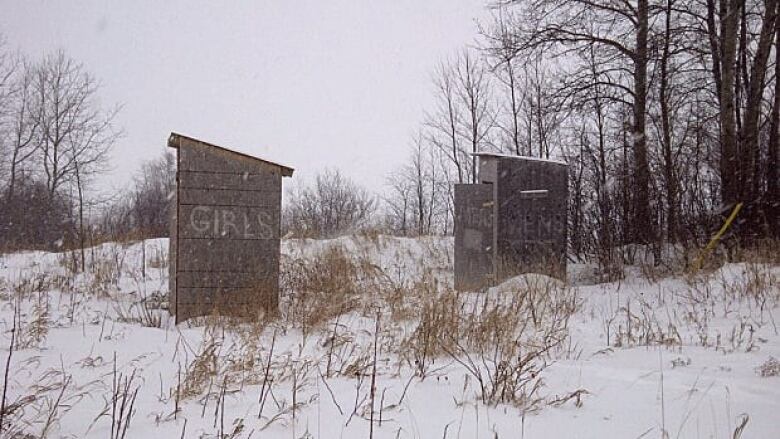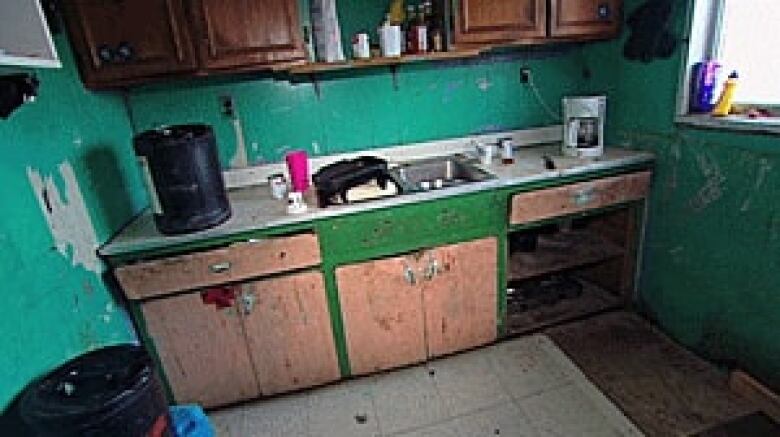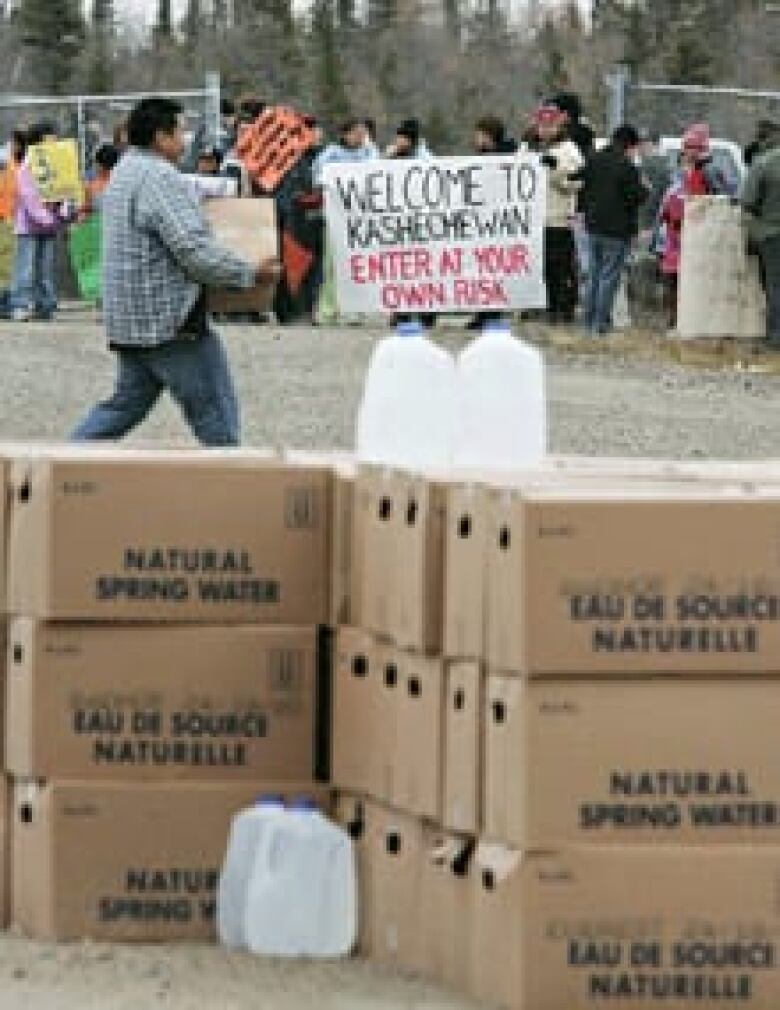Clean running water still a luxury on many native reserves
About 39% of First Nations water systems deemed 'high risk'

For most Canadians, an unlimited supply of clean water flowing freely from a tap and imperceptibly whisking away their waste at the simple push of a lever is a given; for many First Nations, it's a luxury their communities can't afford.
"We have water fountains in the community store; for sewage, we still use outdoor washrooms," said Ian Knott, a band councillor who oversees water and sewer projects for theWasagamack First Nationin northern Manitoba.
The Cree community, which is on the western shore of Island Lake, about 600 kilometres northeast of Winnipeg, built a water treatment plant five years ago and installed water mains in one part of the reserve, but progress since then has been slow, says Knott.
About 60 per cent of the 1,500 residents there still have no indoor plumbing and must resort to using outhouses, slop pails or cisterns, whose contentsare periodically hauled away by sewage trucks. Water is retrieved from communal standpipes or delivered to households by truck.
First Nations infrastructure
The CBC News seriesThe Big Fixexamines Canada's crumbling infrastructure and what's needed to repair it. Storiesthat look atinfrastructure challenges facing First Nations include:
Infrastructure overview: Shacks and slop pails: infrastructure crisis on native reserves.Read the article
Housing: Nearly half of the houses on Canadian reserves require major repairs, andovercrowding rates are six times greater on reserve than off.Read the article
Pikangikum:WatchColeen Rajotte's reportonthetroubled Ojibwa communityand visit the8th Fire Facebook siteto get a preview of 8th Fire, an upcomingCBC-Radio-Canada documentary series on aboriginal peoples in Canada.
"The last time we hadsomething done, [federal officials]said in three years' time we'll do more water lines, but it's been five years now, because the money is tied up elsewhere," Knott said.
Money gets diverted to other communities with their own water problems, and projects get delayed, he said. Meanwhile, theprice of materials and transportation to get them to the remote fly-in community rises, and by the time the money does become available, it doesn't cover the full cost of the original project.
"Every year, costs go up and, somehow, we tend to lose out," Knott said. "They do less than what was projected."
Health problems
Manitoba reserves have some of the worst water problems in the country: six per cent of homes on reserves in that province have no water service at all.Recent attentionfromlocal mediaand a Liberal motion in the House of Commons prompted Aboriginal Affairs Minister John Duncan to announce that thegovernment would spend $5.5 millionto help improve infrastructure in the four communities that make up the Island Lake First Nations, including Wasagamack.

First Nations are responsible for 20 per cent of the costs of maintaining water and sewer systems, and the federal government funds the rest. But in many instances, the federal allocations are not enough to ensure a fully functioning water and sewage system that provides clean, safe water to all homes on reserve.
Even when water is available, it is often inadequately treated or compromised by corroded pipes and aging distribution systems. More than 120 First Nations communities were under a Health Canadawater advisory as of Oct. 31.
Attawapiskat, a Cree community on James Bayin northern Ontario, has been wanting to replace its degraded intake system, which draws water from a small local lake to the community's treatment plant, for10 years but hasn't been able to afford to do so and recently had to suspend water service.
"Right now, people have to pick up water," said Chief Theresa Spence. "They can't use their water tap, because[the water]has a different taste to it."
'I wouldn't agree that the funding has been insufficient.' Gail Mitchell, Aboriginal Affairs and Northern Development Canada
The combination of improper sanitation and bad water quality can lead to a number of health problems, including skin rashes and infections, diarrhea and other gastrointestinal illnesses. It also means infections take longer to heal andinfectious diseases spreadmore easily.
The government says that since 2006 it has spent $2.5 billion on water and wastewater services in First Nations communities, including commitments made through to 2013.
"On an annual basis, the investment is significant, so I wouldn't agree that the funding has been insufficient," said Gail Mitchell, director-general for community infrastructure at Aboriginal Affairs and Northern Development Canada (AANDC).
"I would agree that it's always hard to manage and balance the many priorities that governments face, so that's why, when it comes to infrastructure, long-term planning is so key, and we do support communities in developing five-year plans."
Promises, promises
Over the years, successive governments have vowed to improve water quality and access on reserves in the wake of embarrassing crises such as the2005 E. coli outbreakinKashechewan, which had to have more than 1,000 residentsairlifted out of the northern Ontario reserveafterthey became sick from high levels of the bacteria in their drinking waterand developed skin problems from the excessiveamount of chlorine used totreat it.

But a recentgovernment-commissioned assessmentof water and sewer services on reserves suggests many communities remain vulnerable to the health and environmental problems that result frompoor water quality and inadequate sanitation.
The assessment, which was released in April 2011, looked at the water and sewer systems of 571 First Nations (with a total population of 484,321 and 112,836 "dwellings") and evaluated their water source and how well each system was designed, operated and monitored.
- Shacks and slop pails: Infrastructure crisis on native reserves
- First Nations housing in dire need of overhaul
It categorized 39 per cent of the water systems as "high risk," meaningthey have "major deficiencies" that pose a high risk to water quality and could lead to potential health and safety or environmental concerns. Thirty-four per cent were assessed as posing medium risk to the quality of water and health and having deficiencies that "should be corrected to avoid future problems."
More than half of water systems on B.C. reserves and 46 per cent of those on Ontario reserves were considered high risk. Ontario also had the highest percentage (36 per cent) of sewage systems deemed high risk.
[IMAGEGALLERY galleryid=1541 size=small]
Although the AANDC's protocol on drinking water on reserves is based on provincial standards, there is no regulatory enforcement mechanism to ensure those standards are being met. First Nations are responsible for monitoring water quality in co-operation with Health Canada. But the 2011 auditor general's report found that AANDC and Health Canada "do not ensure that drinking water is tested on a regular basis."
AUDIO: Life on reserve
Listen to CBC Radio's Karen Pauls report on life ontwo Manitoba reserves:
The water problems on the Garden Hill First Nation have caught the attention of the Mennonite Central Committee, which usually works in developing countries.LISTEN
Three generations of the Harper family live in a home on the Wasagamack reservewith no running waterand a slop pailfor a toilet.LISTEN
The government did introduce a water standards billfor reserves last year, but it died on the order paper and has not yet been reintroduced. Even when the bill does resurface, it will likely be some time before it takes effect.
The Assembly of First Nations (AFN)opposed the first draftof the bill, which it said would give the federal government too much power to unilaterally impose the legislation and override treaty rights and First Nations bylaws.
"One of the principal issues is not only the content of what needs to be done but how it needs to be done," said AFN National Chief Shawn Atleo. "Bringing First Nations as full partners to designing solutions is not simply accomplished by a junior bureaucrat phoning up a chief and saying, 'You know, we have a solution for you, by the way; it's just a matter of you agreeing with us.' That's the pattern that got us in this position in the first place."
A big investment
Even with a water standards act in place, the task of bringing reserves' rudimentary water and sewer infrastructure up to those standards will be a colossal job.

The national assessment estimates that it would cost $846 million to bring reserve water systems in line with AANDC's own policiesand $316 million to do the same for wastewater systems.
To meet and maintain allcurrent and futurewater and wastewater needs on reservesfor the next 10 years would cost $4.7 billion in servicing and would require an annual operating and maintenance budget of $419 million.
TheDepartment of Aboriginal Affairshas said it will provide additional funding in 2011-12 to 15 of the communities whose water systems were categorized as high risk in the national assessment and upgrade another 57 water systems by 2015-16.
It's not always practical to hook every resident up to a water main in communities that are remote like Wasagamack or ones with low population density, and often, even when a water main is available nearby, many residents can't afford to pay to be hooked up to it.

According to the assessment, 72 per cent of homes on reserve have piped water service; 13.5 per cent are on truck delivery; 13 per cent have individual wells; and 1.5 per cent have no service. For wastewater, 54 per cent are piped; eight per cent are on truck haul; 36 per cent have individual wastewater systems; and 2 per cent have no service.
"Ultimately, First Nations leadership and First Nations communities are making decisions about planning for the delivery of water services to their members, and they're working with the budgets they have available and making choices," Mitchell said.
"So, there's certainly no question that there's a range of services out there that communities are providing, and the issue of infrastructure planning is, I think, at the heart of it."
Trained plant operators key
Treatment plants on reserve are often aging, deficient or operating beyond capacity, and their lifespan is much shorter than it should be.
"Inadequate operation and maintenance practices or improper operation by poorly equipped technicians have resulted in premature replacement of equipment or system components, and service interruptions," the water assessment found.
It went on to note that many communities rely on outdated treatment technology and old guidelines, and are unable to identify contaminants that have long been treated in other parts of Canada.
A lack of plans to protect water sources is also a contributing factor to poor water quality, althoughthe assessment notes that First Nations can't tackle this problem alone, sincein many casesthe sources of contamination originate off reserve.
One of the primary obstacles that many First Nations face in trying to maintain a well-functioning water and sewage treatment system is a shortage of technicians who are adequately trained to do the necessary monitoring of water quality.

"Sixty per cent of risk relates to who's operating those systems how they're doing it and the kinds of record keeping and processes that they have in place," said Mitchell.
Only 54 per cent of water and 49 per cent of wastewater systems on reserve have a fully certified primary operator, the assessment found. In the most remote communities, only 26 per cent of systems meet operator requirements.
The government spends$10 milliona yearto train First Nations members how to operate their water and sewage systemsthrough its Circuit Rider Training Program. But the demand for suchexpertise still outstrips supply, and many First Nations end up having to hire experts from outside the community to run their treatment plants.
Such is the case inKashechewan, which has partially upgraded and computerized its water treatment plant since the 2005 crisis and brought in an outside company, whichis subject to provincial water quality standards, to operate it.
"We're training our own to be able to take over that responsibility," said Chief Jonathan Solomon. "That's always been the goal. I'm hoping that within a year or a year and a half or two, we will be in that situation."












_(720p).jpg)


 OFFICIAL HD MUSIC VIDEO.jpg)
.jpg)



























































































